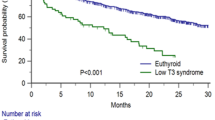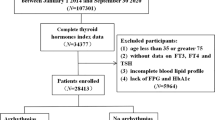Abstract
Purpose
Thyroid dysfunction affects the outcomes of atrial fibrillation (AF) catheter ablation. However, it remains unclear if the variations in thyroid function, especially in the triiodothyronine levels, are associated with AF recurrence in euthyroid subjects. This study investigated the associations of thyroid hormone levels with arrhythmia recurrence after AF catheter ablation in euthyroid patients.
Methods
A total of 1115 consecutive AF patients who underwent catheter ablation were prospectively enrolled and had their thyroid function measured prior to the procedure. The serum free triiodothyronine (FT3), free tetraiodothyronine (FT4), and thyroid-stimulating hormone (TSH) levels were assessed as predictors of recurrence and were adjusted for potential confounders. The subjects were divided into five quintile groups according to the FT3, FT4, and TSH levels, respectively.
Results
After a median follow-up of 723 days (interquartile range, 180–1070), 47.2% of patients experienced recurrence. After multivariate adjustment, subject in the lowest and highest FT3 quintiles showed increased risk of recurrence (hazard ratio [HR] 1.60, 95% confidence interval [CI] 1.26–2.03, P < 0.01, and HR 1.47, 95% CI 1.16–1.87, P < 0.01, respectively), compared to the median quintile of FT3 levels. Regarding the FT4 level, the highest quintile group showed a higher risk of recurrence (HR 1.27, 95% CI 1.01–1.60, P = 0.04). The TSH levels were not associated with AF recurrence.
Conclusions
Both high and low FT3 levels were associated with AF recurrence after catheter ablation. High-normal FT4 levels were also related to AF recurrence; however, no association was found between normal TSH levels and AF recurrence.



Similar content being viewed by others
References
Morin DP, Bernard ML, Madias C, Rogers PA, Thihalolipavan S, Estes NA 3rd. The state of the art: atrial fibrillation epidemiology, prevention, and treatment. Mayo Clin Proc. 2016;91(12):1778–810.
Link MS, Haissaguerre M, Natale A. Ablation of atrial fibrillation: patient selection, periprocedural anticoagulation, techniques, and preventive measures after ablation. Circulation. 2016;134(4):339–52.
Calkins H, Hindricks G, Cappato R, Kim YH, Saad EB, Aguinaga L, et al. 2017 HRS/EHRA/ECAS/APHRS/SOLAECE expert consensus statement on catheter and surgical ablation of atrial fibrillation. Heart Rhythm. 2017;14(10):e275–444.
Gaita F, Scaglione M, Battaglia A, Matta M, Gallo C, Galata M et al. Very long-term outcome following transcatheter ablation of atrial fibrillation. Are results maintained after 10 years of follow up? Europace : European pacing, arrhythmias, and cardiac electrophysiology : journal of the working groups on cardiac pacing, arrhythmias, and cardiac cellular electrophysiology of the European Society of Cardiology 2017.
Jabbar A, Pingitore A, Pearce SH, Zaman A, Iervasi G, Razvi S. Thyroid hormones and cardiovascular disease. Nat Rev Cardiol. 2017;14(1):39–55.
Zhang Y, Dedkov EI, Teplitsky D, Weltman NY, Pol CJ, Rajagopalan V, et al. Both hypothyroidism and hyperthyroidism increase atrial fibrillation inducibility in rats. Circ Arrhythm Electrophysiol. 2013;6(5):952–9.
Liu L, Yun F, Zhao H, Zhang S, Liu Z, Wang X, et al. Atrial sympathetic remodeling in experimental hyperthyroidism and hypothyroidism rats. Int J Cardiol. 2015;187:148–50.
Chaker L, Heeringa J, Dehghan A, Medici M, Visser WE, Baumgartner C, et al. Normal thyroid function and the risk of atrial fibrillation: the Rotterdam study. J Clin Endocrinol Metab. 2015;100(10):3718–24.
Tang RB, Liu DL, Dong JZ, Liu XP, Long DY, Yu RH, et al. High-normal thyroid function and risk of recurrence of atrial fibrillation after catheter ablation. Circ J : Off J Jpn Circ Soc. 2010;74(7):1316–21.
Sousa PA, Providencia R, Albenque JP, Khoueiry Z, Combes N, Combes S, et al. Impact of free thyroxine on the outcomes of left atrial ablation procedures. Am J Cardiol. 2015;116(12):1863–8.
Dong JZ, Sang CH, Yu RH, Long DY, Tang RB, Jiang CX, et al. Prospective randomized comparison between a fixed '2C3L' approach vs. stepwise approach for catheter ablation of persistent atrial fibrillation. Europace: European pacing, arrhythmias, and cardiac electrophysiology: Journal of the working groups on cardiac pacing, arrhythmias, and cardiac cellular electrophysiology of the European society of Cardiology. 2015;17(12):1798–806.
Surks MI, Sievert R. Drugs and thyroid function. N Engl J Med. 1995;333(25):1688–94.
Wongcharoen W, Lin YJ, Chang SL, Lo LW, Hu YF, Chung FP, et al. History of hyperthyroidism and long-term outcome of catheter ablation of drug-refractory atrial fibrillation. Heart Rhythm. 2015;12(9):1956–62.
Kim KH, Mohanty S, Mohanty P, Trivedi C, Morris EH, Santangeli P, et al. Prevalence of right atrial non-pulmonary vein triggers in atrial fibrillation patients treated with thyroid hormone replacement therapy. J Interv Card Electrophysiol : Int J Arrhythm Pacing. 2017;49:111–7.
Cerillo AG, Bevilacqua S, Storti S, Mariani M, Kallushi E, Ripoli A, et al. Free triiodothyronine: a novel predictor of postoperative atrial fibrillation. Eur J Cardio-thoracic Surg : Off J Euro Assoc Cardio-thoracic Surg. 2003;24(4):487–92.
Klemperer JD, Klein IL, Ojamaa K, Helm RE, Gomez M, Isom OW, et al. Triiodothyronine therapy lowers the incidence of atrial fibrillation after cardiac operations. Ann Thorac Surg. 1996;61(5):1323–7. discussion 8-9
Bianco AC, Salvatore D, Gereben B, Berry MJ, Larsen PR. Biochemistry, cellular and molecular biology, and physiological roles of the iodothyronine selenodeiodinases. Endocr Rev. 2002;23(1):38–89.
Gerdes AM, Iervasi G. Thyroid replacement therapy and heart failure. Circulation. 2010;122(4):385–93.
Wang W, Guan H, Fang W, Zhang K, Gerdes AM, Iervasi G, et al. Free triiodothyronine level correlates with myocardial injury and prognosis in idiopathic dilated cardiomyopathy: evidence from cardiac MRI and SPECT/PET imaging. Sci Rep. 2016;6:39811.
Weltman NY, Wang D, Redetzke RA, Gerdes AM. Longstanding hyperthyroidism is associated with normal or enhanced intrinsic cardiomyocyte function despite decline in global cardiac function. PLoS One. 2012;7(10):e46655.
Marrouche NF, Wilber D, Hindricks G, Jais P, Akoum N, Marchlinski F, et al. Association of atrial tissue fibrosis identified by delayed enhancement MRI and atrial fibrillation catheter ablation: the DECAAF study. JAMA. 2014;311(5):498–506.
Author information
Authors and Affiliations
Corresponding author
Ethics declarations
Conflict of interest
The authors declare that they have no conflict of interest.
Electronic supplementary material
Supplementary Table 1
(DOCX 15.3 kb)
Supplementary Table 2
(DOCX 17.1 kb)
Rights and permissions
About this article
Cite this article
Wei, Sb., Wang, W., Liu, N. et al. U-shaped association between serum free triiodothyronine and recurrence of atrial fibrillation after catheter ablation. J Interv Card Electrophysiol 51, 263–270 (2018). https://doi.org/10.1007/s10840-018-0337-z
Received:
Accepted:
Published:
Issue Date:
DOI: https://doi.org/10.1007/s10840-018-0337-z




